
An engagement ring, also known as a betrothal ring, is a ring indicating that the person wearing it is engaged to be married, especially in Western cultures. A ring is presented as an engagement gift by a partner to their prospective spouse when they propose marriage to represent a formal agreement to future marriage. In most Western countries, engagement rings are usually worn only by women, and they are typically adorned with diamonds. In some countries, partners wear matching rings, and engagement rings may also be used as wedding rings. In the Anglosphere, the ring is customarily worn on the left hand ring finger, but customs vary across the world.
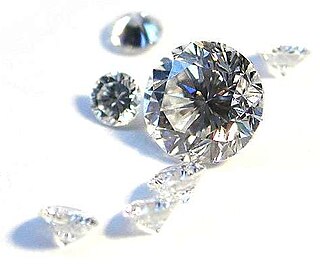
Diamond cutting is the practice of shaping a diamond from a rough stone into a faceted gem. Cutting diamonds requires specialized knowledge, tools, equipment, and techniques because of its extreme difficulty.

In architecture, the capital or chapiter forms the topmost member of a column. It mediates between the column and the load thrusting down upon it, broadening the area of the column's supporting surface. The capital, projecting on each side as it rises to support the abacus, joins the usually square abacus and the usually circular shaft of the column. The capital may be convex, as in the Doric order; concave, as in the inverted bell of the Corinthian order; or scrolling out, as in the Ionic order. These form the three principal types on which all capitals in the classical tradition are based.

Anthony Florian Zaleski, known professionally as Tony Zale, was an American boxer. Zale was born and raised in Gary, Indiana, a steel town, which gave him his nickname, "Man of Steel", reinforced by his reputation of being able to take fearsome punishment and still rally to win. Zale, who held the world middleweight title multiple times, was known as a crafty boxer and punishing body puncher who wore his opponents down before knocking them out. In 1990, Zale was awarded the Presidential Citizens Medal by President George. H. W. Bush.

A Japanese kitchen knife is a type of kitchen knife used for food preparation. These knives come in many different varieties and are often made using traditional Japanese blacksmithing techniques. They can be made from stainless steel, or hagane, which is the same kind of steel used to make Japanese swords. Most knives are referred to as hōchō or the variation -bōchō in compound words but can have other names including -kiri. There are four general categories used to distinguish the Japanese knife designs: handle ; blade grind ; steel ; and construction.

A pre-engagement ring, sometimes referred to as a friendship ring or promise ring, is a ring given as a gift to a romantic partner to signify a commitment to a monogamous relationship, often as a precursor to an engagement ring. A heterosexual couple typically has the man presenting a ring or both exchanging rings, though women may present one as well. They may be worn on any finger due to not being as serious as an engagement ring, though they are sometimes worn on a necklace. These rings are typically purchased by those who are too young to get engaged to their partner or by a partner or partners who do not want to rush into marriage. While similar concepts have been employed in the past, the concept of pre-engagement rings came into prominence starting in the 1970s. It gained further prominence in the late 2000s when celebrities began to use pre-engagement rings such as the Jonas Brothers, Selena Gomez, and Priyanka Chopra.

A brilliant is a diamond or other gemstone cut in a particular form with 57-58 facets so as to have exceptional brilliance. The underside is conical, a shape that provides maximal light return through the top of the diamond. Even with modern techniques, the cutting and polishing of a diamond crystal always results in a dramatic loss of weight; rarely is this loss less than 50%. The round brilliant cut is preferred when the crystal is an octahedron, as often two stones may be cut from one such crystal. Oddly-shaped crystals such as macles are more likely to be cut in a fancy cut—that is, a cut other than the round brilliant—which the particular crystal shape lends itself to.

A diamond cut is a style or design guide used when shaping a diamond for polishing such as the brilliant cut. Cut refers to shape, and also the symmetry, proportioning and polish of a diamond. The cut of a diamond greatly affects a diamond's brilliance—a poorly-cut diamond is less luminous.
The Great Chrysanthemum Diamond is a famous diamond measuring 104.15 carats with a pear-shaped modified brilliant cut, rated in colour as Fancy Orange-Brown and I1 clarity by the Gemological Institute of America. The Great Chrysanthemum is roughly the same size as the re-cut Kohinoor and almost three times the size of the Hope Diamond, The Great Chrysanthemum has the dimensions of 39.10 x 24.98 x 16.00 mm. and features 67 facets on the crown, 57 facets on the pavilion and 65 vertical facets along the girdle. The diamond, designed as a pendant, became the central focus of a necklace with 410 oval, pear-shaped, round and marquis diamonds.
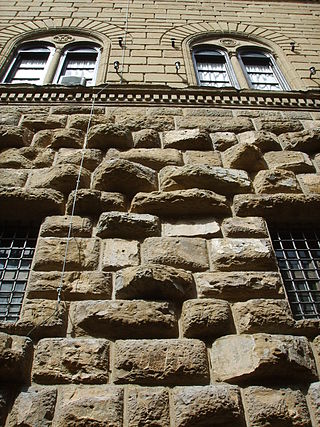
Rustication is a range of masonry techniques used in classical architecture giving visible surfaces a finish texture that contrasts with smooth, squared-block masonry called ashlar. The visible face of each individual block is cut back around the edges to make its size and placing very clear. In addition the central part of the face of each block may be given a deliberately rough or patterned surface.

Harry Winston was an American jeweler. He donated the Hope Diamond to the Smithsonian Institution in 1958 after owning it for a decade. He also traded the Portuguese Diamond to the Smithsonian in 1963 in exchange for 3,800 carats of small diamonds.

A gemstone desired to be used in jewelry is cut depending on the size and shape of the rough stone, as well as the desired piece of jewelry to be made. As a general rule, a cut gemstone will reduce the mass by about 50%.
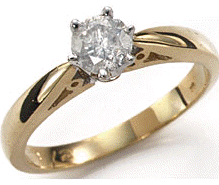
Prong setting or prong mount refers to the use of metal projections or tines, called "prongs", to secure a gemstone to a piece of jewelry. A prong setting is one component of what is known to jewelers as a head, a claw-shaped type of binding that is welded or soldered to a jewelry item to mount a gemstone to the jewelry item. A common setting for diamond engagement rings, the prong setting allows light to strike a gemstone from more angles, increasing its brilliance.
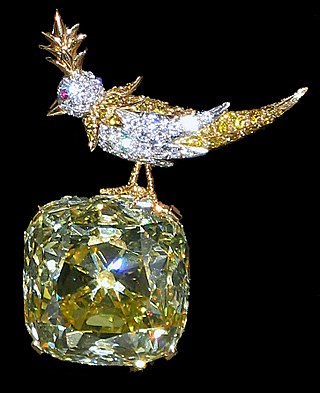
The Tiffany Yellow Diamond is one of the largest yellow diamonds ever discovered. Its carat weight was originally 287.42 carats in the rough when discovered in 1878 in the Kimberley mine in South Africa. It was cut into a cushion shape of 128.54 carats with 82 facets—24 more than a traditional round brilliant—to maximize its brilliance. The facet pattern features eight needle-like facets pointing outward from the culet (bottom) facet. Jewelry and diamond historian Herbert Tillander refers to this as a "stellar brilliant cut", and lists the gem in his book, Diamond Cuts in Historic Jewelry – 1381 to 1910 (1995), among other such diamonds: the Cullinan Diamond, the Koh-i-Noor, the Polar Star, the Wittelsbach, and others.

Diamond is a gemstone formed by cutting a raw diamond. Diamonds are one of the best-known and most sought-after gems, and they have been used as decorative items since ancient times.

Elizabeth II owned a historic collection of jewels – some as monarch and others as a private individual. They are separate from the gems and jewels of the Royal Collection, and from the coronation and state regalia that make up the Crown Jewels.

The Hooker Emerald Brooch is an emerald brooch designed by Tiffany & Co. The brooch is on display in the Janet Annenberg Hooker Hall of Geology, Gems, and Minerals at the Smithsonian Institution's National Museum of Natural History in Washington D.C., United States.

A briolette is a style of gemstone cut. It is an elongated, mostly symmetrical along the main axel, pear shape covered with angular facets usually with a pointed end and no girdle. It is often drilled to hang as a bead. The name is also sometimes erroneously used for pendeloque cut gems. While the briolette is a symmetrical drop shape, the pendeloque cut is flatter and has two different sides: one with a large table facet and one with a point or ridge. The top of a briolette is attached to the piece of jewelry, usually by a hole drilled in the stone, and a pendeloque cut stone needs to be mounted in a prong setting. The briolette is one of the drop cuts for gemstones.
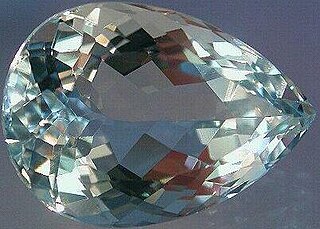
A pendeloque cut is a pear-shaped modification of the round brilliant cut used for diamonds and other gemstones. The pendeloque cut is sometimes erroneously called briolette cut, another drop-shaped cutting design. While the briolette is a symmetrical drop shape, the pendeloque cut is flatter and has two different sides: one with a large table facet and one with a point or ridge. The top of a briolette is attached to the piece of jewelry, usually by a hole drilled in the stone, and a pendeloque cut stone needs to be mounted in a prong setting. The pendeloque is one of the drop cuts for gemstones.
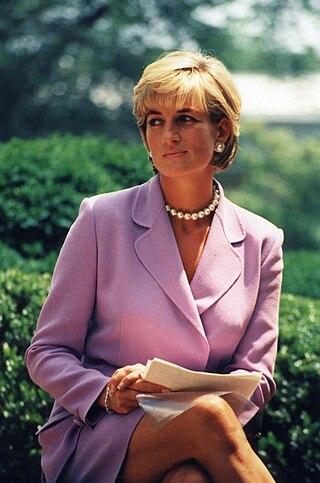
Diana, Princess of Wales, owned a collection of jewels both as a member of the British royal family and as a private individual. These were separate from the coronation and state regalia of the crown jewels. Most of her jewels were either presents from foreign royalty, on loan from Queen Elizabeth II, wedding presents, purchased by Diana herself, or heirlooms belonging to the Spencer family.



















